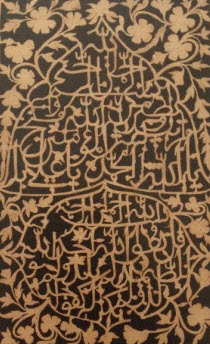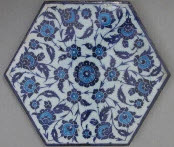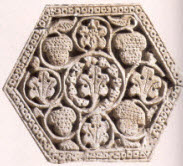Geometric patterns, calligraphy, and vegetal patterns comprise the non-figural decoration in Islamic art. Although geometric ornamentation reached a pinnacle in the Islamic world, the sources for both the shapes and the intricate patterns already existed in late antiquity among the Greeks, Romans, and Sasanians in Iran. In Byzantine art, for example, depictions of people were often framed or linked by geometric and vegetal designs. In Islamic times, the subsidiary elements were transformed into major artistic themes.

The mosaics decorating the Dome of the Rock in Jerusalem, for example, erected by the Umayyad caliph Abd al-Malik in the late seventh century, are derived from the traditions of late antiquity. At first, the artisans employed recognisable floral elements within geometric frames, but eventually they developed a new type of ornamentation in which simple vegetal elements such as tendrils and leaves were subject to the rules of geometry rather than to the laws of nature. In order to describe this style of art, Europeans coined the word “arabesque,” literally meaning “in the Arab style,” in the fifteenth or sixteenth century when Renaissance artists began to incorporate Islamic designs in book ornament and decorative bookbindings. Over the centuries the word has been applied to a wide variety of winding, twining, meandering vegetal decoration in art. This art style became popular due to its adaptability to virtually all media, from paper to woodwork and ivory.appeared in its fully geometrised form in the middle of the tenth century; vegetal forms were assimilated to geometric frameworks: stems and leaves were given geometric shape and geometric frameworks sprouted stems and leaves.

Geometric patterns, with or without the vegetal infill, became very popular in western Islamic lands. It was developed by woodworkers who combined bits of wood and ivory and then applied it to other materials such as tiles that were used extensively to cover surface walls.

The four basic shapes from which the more complicated patterns are constructed are: circles, squares or four-sided polygons, the star pattern derived from squares and triangles inscribed in a circle, and the multi-sided polygons. The circle – which has no beginning and no end and thus symbolises infinity – was considered to be the most perfect geometric form. In mosques, where a wealth of these geometric patterns can be found, one could contemplate the infinite nature of God simply by looking at the walls or the ceilings.

- Stucco decoration in a house in 9th century Samarra, Berlin, Museum of Islamic Art
Geometric patterns were combined, interlaced, and arranged in intricate combinations, thus becoming one of the most distinguishing features of Islamic art. Islamic artists appropriated key elements from the classical tradition, then elaborated upon them in order to invent a new form of decoration that stressed the importance of unity and order. The significant intellectual contributions of Islamic mathematicians, astronomers, and scientists were essential to the creation of this new style. The complex patterns found on many objects allow them to fit into more than one category and are dependent on the artists’ choices about what aspects of the pattern to highlight and what material to use.
Sources:
Sheila Blair, Jonathan Bloom, “Islamic Ornamentation,” Islam: Art and Architecture Edited by Markus Hattstein and Peter Delius, Konemann, 2000
Department of Islamic Art. “Geometric Patterns in Islamic Art,” in Heilbrunn Timeline of Art History. New York: The Metropolitan Museum of Art
